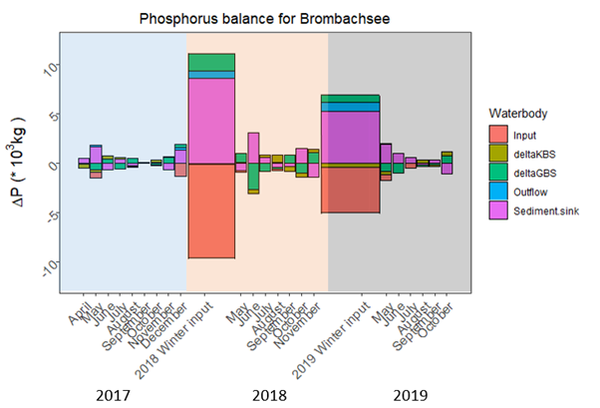Creating a phosphorus balance over the Grosser Brombachsee and the Kleiner Brombachsee: A tale of two lakes
2 Utrecht University
3 Wasserwirtschaft Ansbach
4 UBT, Environmental Microbiology
P 3.8 in Research Poster Kaleidoscope
Introduction/Material & Methods. The Franconian Lake country has been constructed to serve as a water reservoir as well as for recreation purposes. The Lake country consists of five lakes that are separated by dams but are also connected by channels. Periodically these channels are used to transport water through the lakes and ultimately into the Main-Donau channel. The main reservoir is the Grosser Brombachsee (GBS, volume of 80-120 million m3) which is separated from the Kleiner Brombachsee (KBS, volume of 14 million m3) by a dam. GBS has a relatively good water quality, being classified mesotrophic. KBS is considered eutrophic and suffers from periodic algae blooms. In this work the water flows and temperature as well as oxygen and phosphorus concentration data gathered by Water Authority Ansbach (WWA Ansbach) over the years 2017-2019 for GBS and KBS were analysed to calculate a phosphorus balance over the two lakes. This to analyse what sources of phosphorus dominate in these lakes (external/internal) and provide incentive for possible management considerations. Results/Conclusions. The phosphorus balance revealed that the nutrient balance in these lakes, in such close proximity, are actually dominated by distinct loading regimes. For GBS high phosphorus concentrations correspond primarily to phosphorus input from external sources. KBS` phosphorus concentration did not exhibit strong influence by input from external sources. For KBS increases in phosphorus concentration corresponded to internal loading events. Furthermore, it was observed that long lasting thermal stratification can result in “super internal loading events” for semi-deep lakes such as KBS. For deeper lakes, such as GBS, this behaviour could not be observed. Based on the here presented works we conclude that KBS would benefit primarily from internal lake measures whereas GBS would benefit more from measures targeting a reduction in external load.

Phosphorus balance over the Franconian Lake Country
Keywords: Internal loading events, Phosphorus balance, Lake eutrophication


